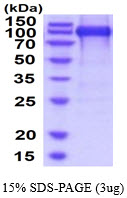Recombinant Human LIFR Protein (NP_002301) (45-833aa) with C-terminus His tag was expressed in Insect cells.
| Size | Price | Qty |
|---|---|---|
| 50ug | $495.00 |

1. Johnson, Rachelle W.; Fingers, Elizabeth C.; Olcina, Monica M.; et al. Induction of LIFR confers a dormancy phenotype in breast cancer cells disseminated to the, bone marrow, NATURE CELL BIOLOGY, 18-10,1078-1089.
"In breast cancer patients, LIF receptor (LIFR) levels are lower with bone metastases and are significantly and inversely correlated with patient outcome and hypoxia gene activity. Hypoxia also reduces the LIFR:STAT3:SOCS3 signalling pathway in breast cancer cells. Loss of the LIFR or STAT3 enables otherwise dormant breast cancer cells to downregulate dormancy-, quiescence- and cancer stem cell-associated genes, and to proliferate in and specifically colonize the bone, suggesting that LIFR:STAT3 signalling confers a dormancy phenotype in breast cancer cells disseminated to bone."
2. Guo, Hongwei; Cheng, Yabin; Martinka, Magdalena; et al. High LIFr expression stimulates melanoma cell migration and is associated with unfavorable prognosis in melanoma, ONCOTARGET, 6-28, 25484-25498.
"Increased or decreased expression of LIF receptor (LIFr) has been reported in several human cancers, including skin cancer, but its role in melanoma is unknown. In this study, we investigated the expression pattern of LIFr in melanoma and assessed its prognostic value. Using tissue microarrays consisting of 441 melanomas and 96 nevi, we found that no normal nevi showed high LIFr expression."
3. Wagener, Eva-Maria; Aurich, Matthias; Aparicio-Siegmund, Samadhi; et al. The Amino Acid Exchange R28E in Ciliary Neurotrophic Factor (CNTF) Abrogates Interleukin-6 Receptor-dependent but Retains CNTF Receptor-dependent Signaling via Glycoprotein 130 (gp130)/Leukemia Inhibitory Factor Receptor (LIFR), JOURNAL OF BIOLOGICAL CHEMISTRY, 289-26, 18442-18450.
"Although all variants induced cytokine-dependent cellular proliferation and STAT3 phosphorylation via CNTFR.gp130.LIFR, only CV-3 induced STAT3 phosphorylation via IL-6R.gp130.LIFR. Quantification of CNTF-dependent proliferation of CNTFR.gp130.LIFR expressing cells indicated that only CV-1 was as biologically active as CNTF. Thus, the CNTFR-selective CV-1 will allow discriminating between CNTFR-and IL-6R-mediated effects in vivo."
Fill out this form and one of our experts will respond to you within one business day.